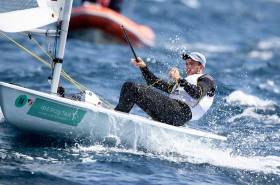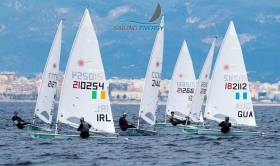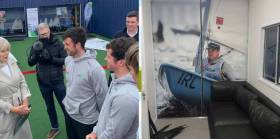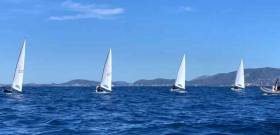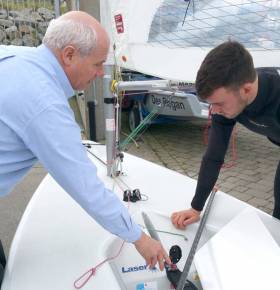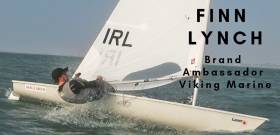Displaying items by tag: Finn Lynch
Finn Lynch Finishes Fourth in Palma, Disappointed Not to Medal But 'Delighted' With Overall Performance
Finn Lynch, Ireland's only medal race contender at the Princess Sofia Trophy this week, has finished fourth overall, narrowly missing out on a bronze medal position in an exciting Laser dinghy finale in a breezy Bay of Palma today.
Despite not making the podium at the final hurdle, the overall result is a major breakthrough for the 21-year-old National Yacht Club sailor who still needs to secure his Tokyo 2020 berth.
The Rio 2016 Olympian had been in second overall earlier in the series and qualified for the top ten medal race final on Saturday morning in seventh place beating, among others, former Olympic champion Robert Scheidt of Brazil.
High winds and big seas delayed the final race but it still went ahead in the challenging waves.
“If I was offered fourth at the start of this regatta I’d have taken it without thinking”
“I think if I was offered fourth at the start of this regatta I’d have taken it without thinking,” he said after the medal race ended. “I sailed really well and I’m super happy with fourth overall.”
There were 187 competitors in his event that included multiple Olympic and world champions and Lynch’s consistent form continues to mark his progress after also making the medal race final in Miami two months ago.
“When I came out of the harbour, I had a big smile on my face that I saw the big waves; I was really excited. I know a lot of people think I can’t perform in those conditions so I hope I’ve proved some people wrong and others right that no matter what the conditions I can still do well.”
The fleet also included Howth’s Ewan McMahon who ended the Gold fleet series on Friday in 29th place overall and is the top Under 21-year old as a result.
Full results are here Check out all our Irish Olympic sailing coverage in the build-up to Tokyo 2020 here
Passing one boat on the final leg of the medal showdown was enough to secure a first major regatta title for the USA’s Christopher Barnard. The sailor from Newport Beach, Calif. lead into the medal race which was won by GBR’s Eliot Hanson who finished runner up ahead of his two times World Champion compatriot Nick Thompson.
Barnard misses out on US selection to the test event to fifth placed Charlie Buckingham – their selection is aggregated over Miami and Palma - but was pleased to round out his regatta win.
“I'm extremely happy, relieved and emotionally exhausted.” Grinned Barnard, “This is by far the biggest regatta I've won. I've been happy with the way I've sailed all week and today I showed a really good fight. That's probably what I'm most proud of.”
“All week I sailed really consistently to put myself in a strong position going into another race and it definintely didn't start according to plan. Big breeze like today has never been my strongest condition but it's been a work in progress.”
“Charlie will go to the test event. For myself I'm disappointed with Miami, I didn't finish very well. I did everything I needed to do here to have a good result, but Charlie earned that spot, He sailed two really consistent events. So I will work hard to keep on improving and focus on our Olympic Trials.”
After a stand out performance this week, the National Yacht Club's Finn Lynch (21) can take a silver or bronze medal in tomorrow's medal race final of the Laser class at the Princess Sofia regatta in Mallorca.
Lynch is lying seventh from 187 slipping back from the second overall he held going into today's final two gold fleet races.
"I'm three points off bronze after a mixed day on the water. I sailed well in Race 1 and had a big catch up to finish 12. I'm disappointed with my Race two result of 26 in tricky 10-15 knot winds and big waves. Very excited for the medal race tomorrow and be in contention for a podium finish!", the young Irish contender said after racing.
Ewan McMahon is Top U21 Performer
In the same event, Howth Yacht Club’s Ewan McMahon ended his Gold fleet series today in 29th place overall in only his first ever appearance at Gold fleet senior level and he comfortably becomes the top sailor aged under 21 in the Laser competition.
 Ewan McMahon - top performance at the first attempt in Palma Photo: Sailing Energy
Ewan McMahon - top performance at the first attempt in Palma Photo: Sailing Energy
Lynch and McMahon have both sailed a gruelling 10-race schedule since Monday in a full range of conditions. A third Irish Laser sailor, Liam Glynn from Belfast Lough, won the final two races to win the Bronze fleet but was disappointed not to feature higher in the overall standings.
At 19, Lynch was the youngest competitor in his class when he made his Olympic debut at Rio 2016.
The annual Princess Sofia regatta for Olympic classes is celebrating its 50thanniversary this year and has attracted a bigger than usual with more than 800 boats and 1,300-plus athletes taking part across all ten Olympic disciplines.
The Laser class medal will be sailed at 1100 (Irish time) on Saturday 6th April.
Full results are here Check out all our Irish Olympic sailing coverage in the build-up to Tokyo 2020 here
Finn Lynch Back in Second Overall in Palma, National Yacht Club Sailor Now Just Two Points off Leader
The National Yacht Club's Finn Lynch is just two points off the overall lead of the 170-boat Laser fleet in a breakthrough performance at Mallorca’s 50th anniversary Trofeo Princesa Sofia Iberostar Regatta.
A 13 and a 5 scored today in changeable conditions by the 22-year-old Count Carlow sailor have put him back into second overall after eight races sailed.
The result puts Lynch, a Viking Marine Ambassador, firmly into Saturday's top ten medal race final and with it the tantalising prospect of Ireland's first ever Laser medal from Palma.
Howth Yacht Club's Ewan McMahon, the U21 sailor competing in his second ever senior international regatta made the gold fleet and is placed 30th.
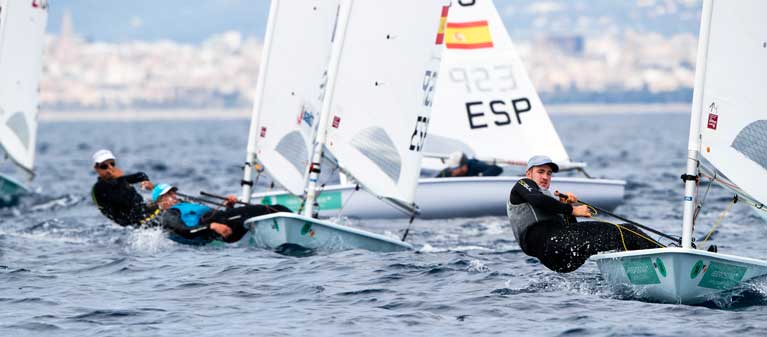 Finn Lynch (right) in control on the approach to a Windward mark Photo: Jesus Renedo
Finn Lynch (right) in control on the approach to a Windward mark Photo: Jesus Renedo
Keeping his own focus – controlling the controllables as the coaches are fond of saying - and trying not to concern himself with the performance of his selection rivals, is clearly working for the young USA sailor Chris Barnard who stepped to the top of the giant Laser fleet today. His main selection rival is 2016 Olympian Charlie Buckingham who lies eighth after today.
“Key for me today was avoiding the bad race in these crazy conditions. It was about keeping focused and composed and I managed that.” Said Barnard, “I tried to keep going fast and avoid the big risks. Our trials for the test event are Miami and here. I have to make up ten places on Charlie. I am just focused on what I need to do. I can’t control him.”
The trials for the one GBR Laser spot have five serious contenders. At the end of today three are in the top seven, Elliot Hansen vaulting into third overall as Lorenzo Chiavarini – who started the day in second – had a bitterly painful day, scoring a 34th and then a DNF which drop him to seventh overall.
“It was a terrible day. The last race I came off the start line in decent pressure and the left side was then completely cut out of wind. Then I was in a hole for a couple of minutes. It is desperate when these are the trials.” Chiavarani explained.
Past world champion Nick Thompson of GBR won the first race and now lies fifth while young Lynch holds on to second, two points off the lead.
Full results are here Check out all our Irish Olympic sailing coverage in the build-up to Tokyo 2020 here
The National Yacht Club's Finn Lynch stays top five overall in the Laser class as the split from qualifying to finals racing arrived yesterday at the Trofeo Princesa Sofia Iberostar. The strongest breeze of the regatta so far arrived as if on cue. The step up to gold fleet racing can be a blessing or a curse but for Lynch, who is having a stand out performance this week, it is definitely another blessing that follows on directly from a similarly stellar performance last January in Miami.
Norway’s Hermann Tomasgaard still leads the men, rallying to a ninth after 23rd place wobble in the first Finals race. Lynch had a 14th and a 23rd place which he discarded as his worst score to date.
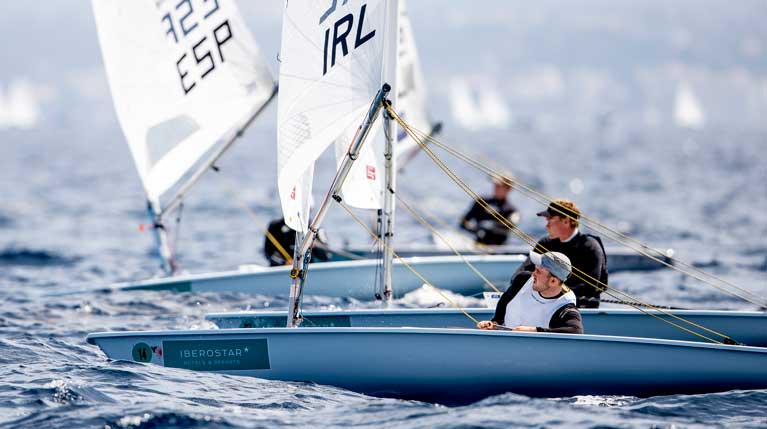 Finn Lynch is in the to top five of the 170 boat Laser class in Palma Photo: Sailing Energy
Finn Lynch is in the to top five of the 170 boat Laser class in Palma Photo: Sailing Energy
Howth's Ewan McMahon Makes Gold Fleet
In another stand out performance for Ireland, Howth Yacht Club's under-21 sailor Ewan McMahon made the gold fleet cut at only his second attempt at senior level. In fact, McMahon was racing alongside Lynch at one stage before finishing in the 20s in their 60-strong gold fleet. The 2016 Laser Radial World silver medalist has embarked on his own Olympic campaign after a string of Laser successes at youth level.
Adding to the strong showing for the British team overall today, Lorenzo Chiavarini won the second contest and lies second. Racing continues today.
Full results are here Check out all our Irish Olympic sailing coverage in the build-up to Tokyo 2020 here
Laser Sharp Finn Lynch Stays Second Overall In Palma
Consistency in tricky conditions has enabled Finn Lynch to maintain his second overall in a stand out performance after four races at Palma, Mallorca’s giant Trofeo Princesa Sofia regatta. It heightens the prospect of a medal race finish – and maybe more – this Saturday for the National Yacht Club solo sailor.
"I'm delighted with a big catch up in Race 1 to finish second after rounding the first mark in 13th", the 22-year-old said, chalking up his third second of the regatta in a scoresheet with four top five results (currently discarding a fifth from race four).
Norway’s Miami winner in January Herrmann Tomasgaard leads the Laser class from Lynch and while there may be some notable absentees in the massive 170-boat entry (such as world ranked number one Sam Meech of New Zealand and Olympic champion Tom Burton of Australia) there is no doubting the significance of the Dublin Bay sailor's breakthrough in Palma. In his wake in these qualifying rounds are, for example, double world champion, Britain's Nick Thompson in 12th and in 23rd place Robert Scheidt the Brazilian sailor, who has won two gold medals, two silver medals and a bronze from five Olympic Games.
Howth's Ewan McMahon, the 2016 Laser Radial World silver medalist, now embarked on an Olympic campaign is 48th. Ballyholme's Liam Glynn is 156th in the regatta that kick starts the Olympic classes season in Europe.
Full results are here
The fleet will be split into gold, silver and bronze divisions on Thursday.
"Delighted" Finn Lynch Lying in Second Place in Palma
Two seconds for a delighted Finn Lynch puts the Laser sailor second overall in the 187-boat fleet in the Princess Sofia Trophy in Palma this morning. It's an explosive start as the Dublin Bay sailor goes in search of Olympic qualification for Tokyo this season and, what's more, it follows on from impressive results obtained at the first round of the World Cup Miami in January too.
"I'm delighted with the results today and keen to push on tomorrow" Lynch declared.
The performance was all the more impressive for the 22-year-old, who acts as a Viking Marine Ambassador, as he led for most of the opening race only to suffer a yellow flag penalty from an on-the-water race judge.
 The scoreboard of the Palma regatta represents a dream start for the National Yacht Club's Finn Lynch
The scoreboard of the Palma regatta represents a dream start for the National Yacht Club's Finn Lynch
A long opening day of the 50th anniversary edition of the regatta was more frustrating for the classes which were sent out to race earlier in the day, the Nacra 17, Lasers and Laser Radials racing out from Ca’n Pastilla had to contend with an unsettled, very light offshore wind before the afternoon sea breeze which took time to fill.
Howth Yacht Club's Ewan McMahon (Under 21) is 40th and Ballyholme's Liam Glynn is 130th having not competed in the first race.
Results are here. Read more about Irish hopes for Tokyo 2020 here.
Rio Laser sailor Finn Lynch who is campaigning for a place in Tokyo 2020 and who is a Viking Marine Brand Ambassador has endorsed the opening of the new Irish Sailing High-Performance centre (pictured above) for the Olympic Sailing team at Dun Laoghaire.
According to Lynch, the HQ is a 'huge milestone for Irish sailing and a legacy that came from the great results at the Rio Olympics'.
'When we stepped over the line into the HQ last week we were buying into a set of standards that we as a group of sailors had developed'. The HQ has given us all the facilities we need to succeed and now it is up to us as the sailors to make it happen. And so, 'If it is to be - it's up to me', the National Yacht Club sailor declared.
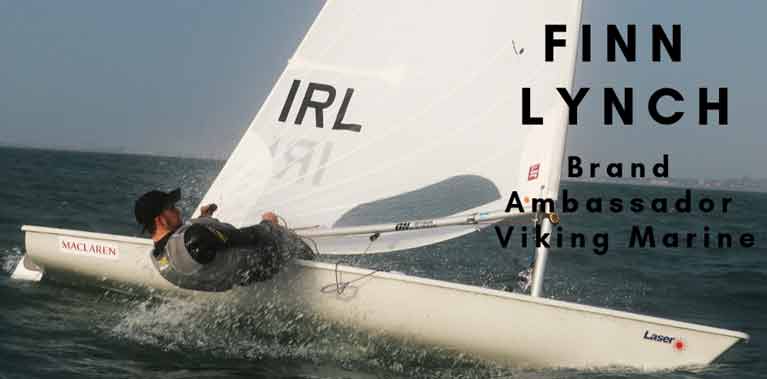
Viking Marine's Finn Lynch Trains with Robert Scheidt, Nine Times Laser World Champion
Tokyo 2020 trialist Finn Lynch who has returned home to Dublin just home is telling of one of the highs from his week Laser training in Palma de Mallorca.
Lynch, a Viking Marine ambassador told Afloat.ie 'When nine-time Laser world champion Robert Scheidt asks to join your training, you know you are doing something right! When my coach Vasilij Zbogar won his first medal (bronze in Athens) Scheidt won Gold. Pretty cool!'
Lynch is back on Dublin Bay for next week's opening of the Irish Sailing Performance HQ in Dun Laoghaire.
In a busy week in Mallorca, Olympian Finn Lynch, a Brand Ambassador to Viking Marine, shares his weekly tips.
This week Lynch focuses on the merit of setting personal performance goals and the motivational advantage of some early personal wins.
'We all know my dream goal is to win an Olympic gold medal for Ireland! But having smaller process goals are a great way to keep you focussed on what you should be doing right now and not thinking too far ahead.
This winter I wanted to improve my fitness and strong wind sailing. Yesterday on our Irish Sailing Group bike ride I hit a personal goal that I know puts me right up there within the laser fleet in bike fitness! Happy days!

Viking Marine Brand Ambassador Finn Lynch Talks Laser Goals: ‘Start As You Mean To Go On’
“I have some hefty goals for 2019 and being top 10 in the Miami World Cup was my first goal of the year,” says Viking Marine’s new brand ambassador Finn Lynch.
“I’m delighted to say that I can confirm that training does pay off!”
The Laser contender for a spot in Tokyo 2020 has a mentally taxing week in Florida last month, but all was worth it to become the first men’s Laser sailor to qualify for a World Cup medal race.
That alone would have been something to celebrate, if not for Finn pulling out all the stops in that final race to make the top 10.
“Who would have thought it? Miami was a breakthrough regatta in that I bridged the gap from my World Cup performances last year,” he says.
“My previous best regattas were 16 and 17 in a World Cup. After training very hard all winter, I managed to jump to top 10. Now let’s try to keep form until Palma in April — my next big regatta.”
And that is precisely what he’s been doing. More recently, and across the Atlantic, Finn followed up his superlative performance in Miami with fourth place overall at round 2 of the Villamoura Coach Regatta in Portugal.
This past week he resumed training in Dublin with just a few weeks to go before the opening of the Laser team’s purpose-built Irish Sailing performance HQ in Dun Laoghaire.


























